
Are you constantly feeling drained, stressed, and disconnected from your own wellbeing? I’ve been there too – struggling to balance everything while my own health took a backseat. The good news is that transforming your wellness doesn’t require a complete lifestyle overhaul! Small, consistent actions can create remarkable shifts in how you feel physically, mentally, and emotionally.
Wellness isn’t just about green smoothies and yoga (though those can be wonderful!). It’s about creating sustainable daily practices that honor your unique needs and circumstances. Throughout my own wellness journey, I’ve discovered that the most powerful changes come from small habits that feel good enough to maintain consistently. When we approach wellness with self-compassion rather than rigid rules, we create lasting change that genuinely enhances our quality of life.
Ready to discover practical wellness strategies you can actually implement in your busy life? This comprehensive guide breaks down 15 essential wellness practices across all dimensions of health – from morning rituals that energize your day to sleep optimization techniques that transform your recovery. You’ll learn science-backed approaches to nutrition, movement, stress management, and more that you can customize to fit your unique lifestyle and preferences. Let’s dive in and start creating your personalized path to vibrant well-being!
This post may contain affiliate links. I only recommend products and services I genuinely believe in. Additionally, some images on this website may have been created with the help of AI to convey the feeling I wish to share with the reader.
What You Might Need
- A journal for tracking wellness habits and reflections
- Comfortable clothes for movement practices
- Water bottle for hydration
- Basic meditation app (many free options available)
- Space in your home dedicated to wellness activities
- Support from friends, family, or wellness mentor
- An open mind and self-compassion
1. Morning Rituals That Set the Tone for Wellness
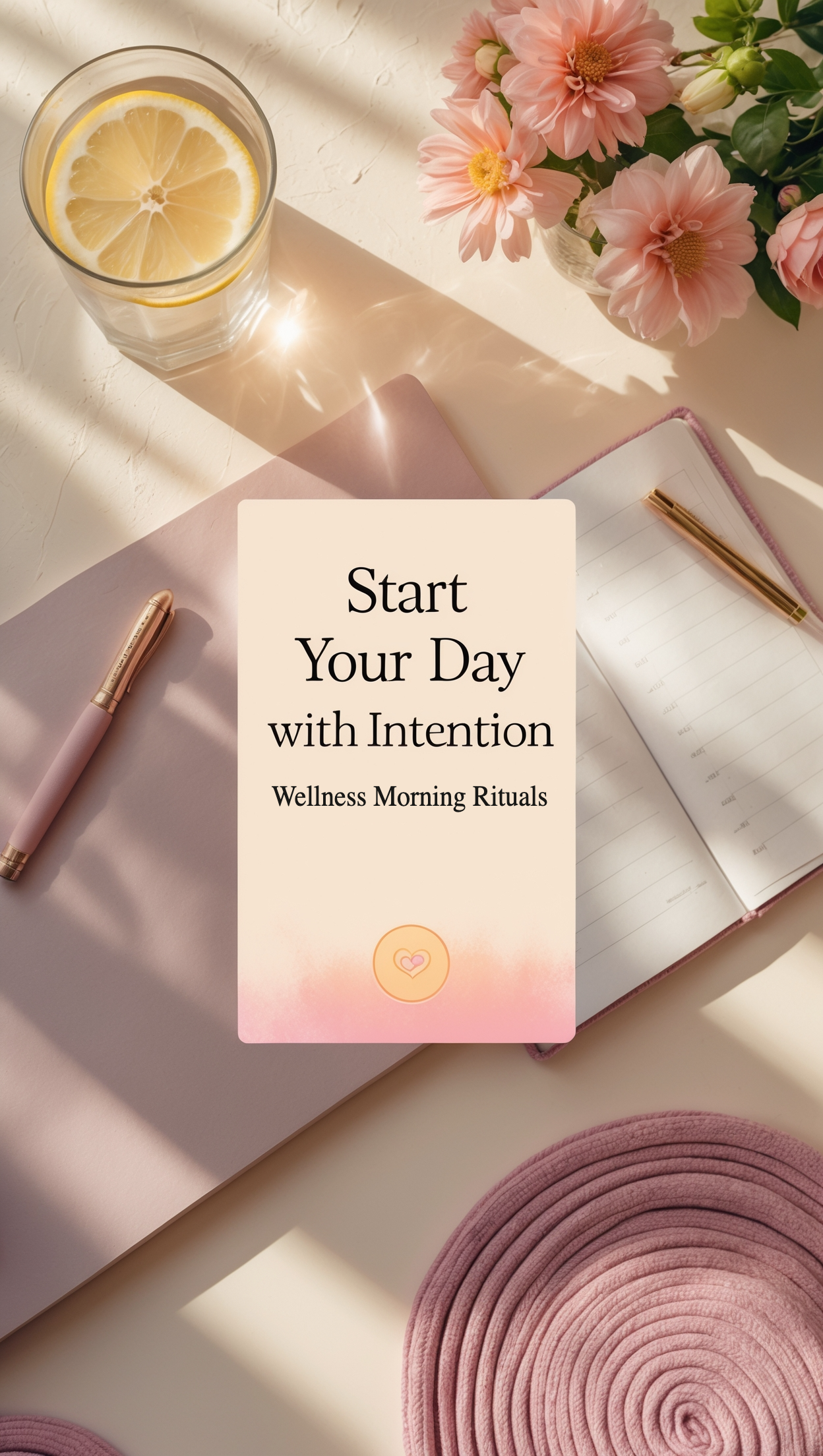
Every morning presents a fresh opportunity to set positive intentions for your well-being! I’ve found that my entire day flows differently when I protect those first precious minutes after waking instead of immediately reaching for my phone. The rituals we create during this time can significantly impact our stress levels, energy, and mental clarity throughout the day – regardless of what challenges might arise later.
Morning routines don’t have to involve 5 am workouts or elaborate meditation sessions to be effective (unless those genuinely work for you!). The key is creating consistent practices that signal to your body and mind that you’re transitioning into your day with intention rather than reaction. When you approach your mornings with purpose, you’re essentially programming your nervous system for greater resilience before the day’s demands begin competing for your attention.
The Science Behind Morning Cortisol Management
Morning is when cortisol naturally peaks in your body. A structured morning routine helps regulate this hormone, preventing the stress-induced spikes that can leave you feeling anxious and overwhelmed. The difference between a managed cortisol response and an unmanaged one can dramatically affect your energy levels throughout the day.
Hydration’s Impact on Morning Energy
Your body becomes naturally dehydrated during sleep. Consuming 16-20 ounces of water within 30 minutes of waking rehydrates your system and jumpstarts metabolism. This simple practice alone can improve energy more effectively than caffeine for many people.
Mindfulness Before Technology
Creating a buffer between waking and checking devices allows your brain to establish its own priorities rather than immediately responding to others’ demands. This boundary-setting practice strengthens your attention muscles and reduces reactive anxiety.
How to Create Your Personalized Morning Ritual
- Start small with just 5-10 minutes of protected morning time
- Experiment with different activities until you find what genuinely energizes you
- Stack new habits onto existing ones (like drinking water while the coffee brews)
- Prepare your morning environment the night before to remove friction
- Track how different morning practices affect your energy and mood throughout the day
- Adjust seasonally as your body’s needs change with daylight and temperature shifts
Picture This:
You open your eyes as gentle morning light filters through your curtains. Instead of immediately grabbing your phone, you take three deep breaths and set a simple intention for the day. After hydrating with room-temperature water infused with lemon, you spend just five minutes stretching or journaling before the household stirs. This brief but intentional wellness ritual creates a foundation of calm and clarity that carries through your day, helping you respond rather than react to whatever challenges arise. You notice yourself feeling more centered, present, and energized – all from protecting those first precious minutes of consciousness.
2. Nutrition Fundamentals for Everyday Wellness

Food is so much more than fuel – it’s information for our bodies! I’ve transformed my relationship with eating by focusing on nourishment rather than restriction, which has completely changed both my energy levels and my enjoyment of meals. Nutrition doesn’t need to involve complicated diet rules or eliminating entire food groups to be effective for wellness.
The most sustainable approach to healthy eating combines nutritional science with personal enjoyment and cultural preferences. When we understand how different foods affect our unique bodies, we can make choices that support our well-being without sacrificing pleasure or connection. The goal isn’t perfection but consistency – finding nutrient-dense foods you genuinely enjoy eating regularly while maintaining a flexible, judgment-free relationship with all foods.
The Connection Between Gut Health and Mood
Emerging research has established the gut as our “second brain,” with gut bacteria producing neurotransmitters that significantly impact mood and mental health. Consuming diverse plant foods feeds beneficial gut bacteria, potentially improving both digestion and emotional well-being through this gut-brain connection.
Anti-Inflammatory Foods as Medicine
Chronic inflammation underlies many modern health challenges. Foods rich in omega-3 fatty acids, antioxidants, and polyphenols naturally combat inflammation without medication. Incorporating these foods daily creates a cumulative effect that supports cellular health and disease prevention.
Mindful Eating for Improved Digestion
The pace and awareness with which you consume food dramatically affects nutrient absorption and satisfaction. Slowing down activates proper digestive processes, reduces overeating, and enhances the sensory pleasure of meals.
Steps to Create Sustainable Nutrition Habits
- Add foods before subtracting – focus first on incorporating more nutrient-dense options
- Create a “food environment” that makes healthy choices convenient (prep vegetables ahead, keep fruit visible)
- Practice the 80/20 approach – emphasize nutritious foods most of the time while allowing flexibility
- Experiment with meal timing that supports your energy patterns and hunger cues
- Consider keeping a food-mood journal to identify personal patterns and sensitivities
- Prioritize eating in relaxed settings rather than while distracted or stressed
Picture This:
You approach your plate with curiosity rather than judgment, savoring a colorful meal filled with vegetables, quality proteins, and whole foods that you genuinely enjoy. Between bites, you place your fork down and actually taste the flavors, noticing the satisfaction that comes from both the nutrients and the experience of eating mindfully. Your relationship with food feels peaceful rather than complicated – you understand what nourishes your unique body while still enjoying social meals and occasional treats without guilt. This balanced approach to nutrition provides sustainable energy throughout your day while fostering a positive relationship with eating that supports your overall wellness journey.
3. Movement Practices That Fit Into Any Lifestyle

Finding joy in movement transformed my entire approach to exercise! After years of forcing myself through workouts I dreaded, I discovered that sustainable fitness comes from activities that energize rather than deplete you. The human body is designed to move regularly in varied ways, yet our modern lifestyles have made movement optional rather than integral to daily life.
The wellness benefits of consistent movement extend far beyond weight management or aesthetics. Regular physical activity improves cognitive function, emotional regulation, immune response, and longevity – regardless of intensity level or duration. When we reframe exercise as a form of self-care rather than punishment, we naturally become more consistent and actually look forward to moving our bodies in ways that feel good.
Movement as Mood Medicine
Physical activity triggers the release of endorphins, dopamine, and serotonin – nature’s antidepressants and anxiety relievers. Even 10-minute movement sessions can significantly shift your emotional state when you’re feeling low or stressed.
Functional Fitness for Everyday Life
Movement that mimics real-life activities strengthens the body for practical, everyday functions. This approach improves quality of life by enhancing your ability to carry groceries, play with children, or maintain mobility as you age.
Consistency Over Intensity
Research consistently shows that moderate, regular movement produces greater long-term health benefits than occasional intense workouts. Creating sustainable movement habits prevents injury and burnout while building momentum for lifelong fitness.
How to Build Movement Into Your Day
- Schedule movement appointments with yourself just like any important meeting
- Break exercise into 10-minute “movement snacks” throughout your day if time is limited
- Combine movement with other activities (walking meetings, audiobooks during workouts)
- Find accountability through movement buddies or community classes
- Track your energy and mood before and after different types of movement
- Create visual cues for movement in your environment (keep resistance bands visible, yoga mat unrolled)
Picture This:
You’ve discovered forms of movement that actually feel good in your body – perhaps it’s dancing in your living room, taking mindful walks in nature, or flowing through yoga poses that release tension from your day. Movement has transformed from something you “should do” into something you genuinely look forward to because of how it makes you feel: stronger, more energized, and more connected to yourself. You no longer measure success by calories or minutes but by consistency and joy. This sustainable approach to physical activity has become a natural part of your wellness routine, supporting everything from better sleep to improved mood and increased resilience against stress.
4. Sleep Optimization Techniques for Better Recovery
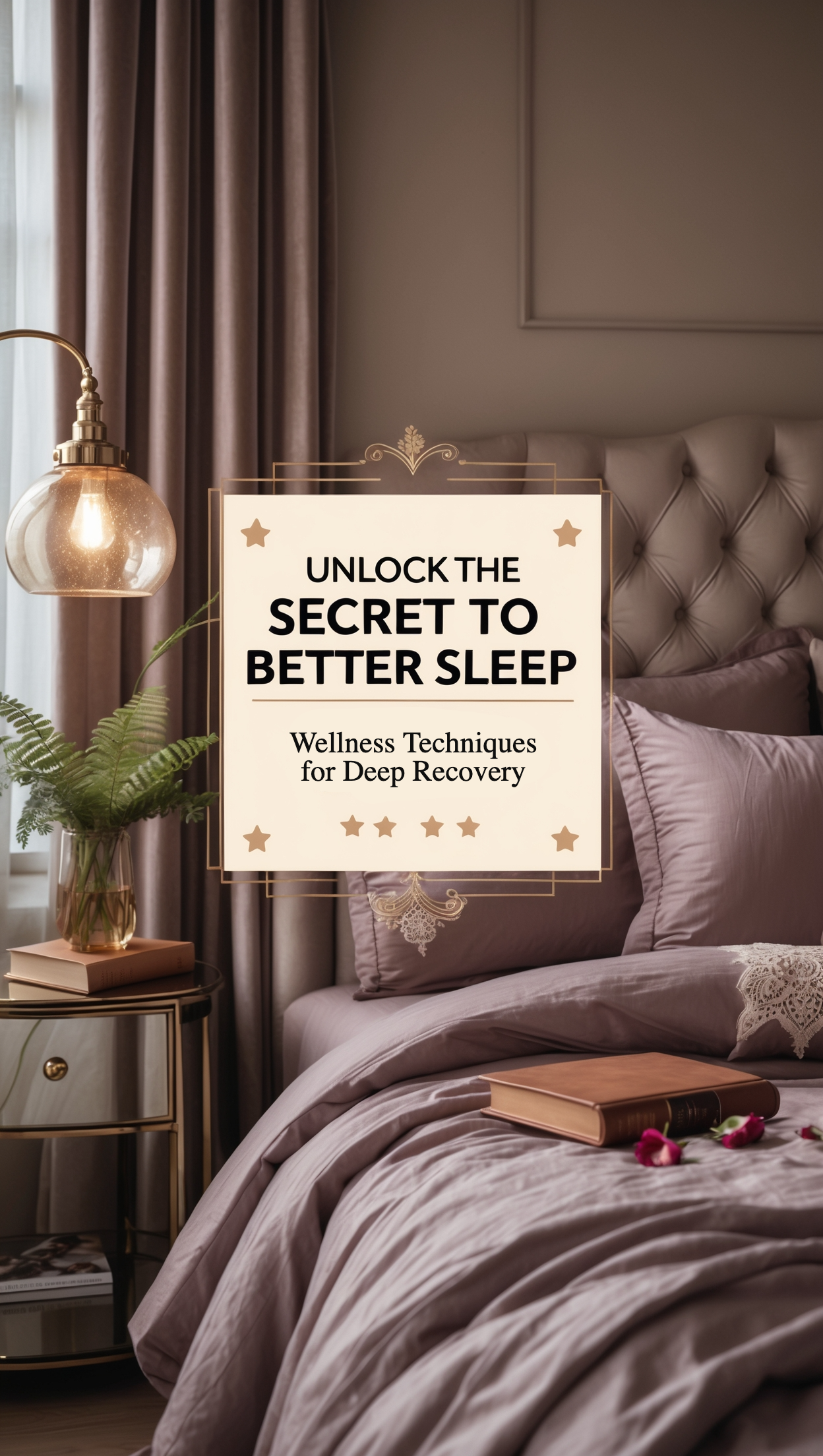
Sleep is truly the foundation of all other wellness practices! I’ve learned that no amount of nutrition, exercise, or stress management can compensate for chronically poor sleep quality. Our bodies perform critical restoration processes during different sleep stages – from hormone regulation to memory consolidation and immune system strengthening.
Modern lifestyles often work against our natural sleep-wake cycles, with artificial light, technology, and busy schedules disrupting the circadian rhythms we’ve evolved with over millennia. By understanding sleep as an active, essential biological process rather than just “downtime,” we can create conditions that support this vital aspect of wellbeing and experience profound improvements across all dimensions of health.
The Neurological Benefits of Quality Sleep
During deep sleep phases, the brain’s glymphatic system activates, clearing waste products and toxins that accumulate during waking hours. This cleaning process appears crucial for cognitive function and may help prevent neurodegenerative conditions when consistently achieved.
Hormonal Regulation Through Sleep Cycles
Sleep quality directly impacts hormones controlling hunger, stress response, and metabolism. Insufficient sleep disrupts ghrelin and leptin balance, increasing cravings for high-calorie foods while reducing satiety signals.
REM Sleep and Emotional Processing
The REM stage of sleep plays a crucial role in emotional regulation, helping process difficult experiences and consolidate emotional memories. Consistent REM sleep may improve resilience to stress and reduce emotional reactivity.
Steps to Transform Your Sleep Environment
- Establish a consistent sleep-wake schedule, even on weekends
- Create a technology-free buffer zone of 30-60 minutes before bed
- Optimize your bedroom for darkness, quiet, and comfortable temperature (60-67°F ideal for most people)
- Consider sleep-supporting supplements like magnesium glycinate or L-theanine if appropriate
- Develop a relaxing pre-sleep ritual that signals your body it’s time to wind down
- Track your sleep patterns to identify personal disruptors and quality enhancers
Picture This:
Your bedroom has become a sanctuary for rest, free from work materials and electronic distractions. Each evening, you move through a calming ritual that signals to your body that it’s time to transition from the day’s activities – perhaps a warm shower, gentle stretching, and reading by soft light. As you settle into sleep, your mind quiets naturally, having been prepared by consistent sleep hygiene practices. You wake feeling genuinely refreshed, with stable energy throughout the day rather than afternoon crashes. This foundation of quality sleep enhances every other wellness practice, creating a positive cycle of improved energy, mood, and cognitive function that transforms how you experience each day.
5. Stress Management Strategies for Modern Life

Stress isn’t inherently negative – it’s our relationship with it that matters! I’ve discovered that while we can’t eliminate stressors completely, we can transform how we respond to them. Our bodies aren’t designed to handle the constant, low-grade stress that characterizes modern life, which is why intentional stress management has become essential for wellness rather than optional.
Effective stress management involves both preventative practices that build resilience and responsive techniques for navigating acute stress when it arises. By developing awareness of your personal stress signals and having practical tools ready before you need them, you create an internal environment that can weather challenges without becoming overwhelmed or depleted.
The Physical Impact of Chronic Stress
Prolonged stress responses keep cortisol and adrenaline elevated, potentially contributing to inflammation, immune suppression, and cardiovascular strain. Learning to regulate your nervous system interrupts this cascade before physical symptoms manifest.
Cognitive Restructuring for Stress Perception
How we interpret stressful situations significantly impacts their effect on our well-being. Developing flexible thinking patterns allows you to reframe challenges as opportunities for growth rather than threats.
Boundary Setting as Stress Prevention
Clearly defined personal and professional boundaries protect your energy resources and prevent the depletion that leads to chronic stress. Effective boundary communication is a learnable skill that supports wellness.
How to Create Your Personalized Stress Management Toolkit
- Identify your unique stress signals (physical sensations, thought patterns, behavioral changes)
- Practice quick breathwork techniques that can be used anywhere (box breathing, 4-7-8 breath)
- Schedule regular nervous system “reset” activities (nature time, creative expression, movement)
- Create communication templates for setting boundaries in different situations
- Maintain a list of perspective-shifting questions to ask yourself during stressful moments
- Build a “stress first aid kit” with sensory tools that help regulate your nervous system
Picture This:
You notice the familiar tension building in your shoulders and recognize it as an early warning sign of stress. Instead of pushing through or ignoring it, you pause to take three deep breaths, momentarily stepping away from the situation. You’ve developed the awareness to catch stress responses before they escalate and have practical tools ready to implement. Rather than being controlled by stress, you’ve learned to work with your nervous system, understanding when to push forward and when to rest. This balanced approach to stress management has transformed your resilience, allowing you to navigate life’s challenges while maintaining your wellness foundation. You’ve discovered that stress management isn’t about eliminating stressors but about creating space between stimulus and response.
6. Mindfulness and Mental Wellness Practices

Mindfulness transformed my relationship with my own thoughts! I’ve found that training my attention through simple daily practices has created more space between stimulus and response in my life. Mental wellness doesn’t mean eliminating negative emotions or challenging thoughts – it means developing a healthier relationship with our inner experience.
Our minds naturally wander to the future or past, but developing present-moment awareness helps us engage more fully with our lives as they’re actually unfolding. Even brief mindfulness practices can strengthen neural pathways that support emotional regulation, cognitive flexibility, and resilience against stress. The goal isn’t to achieve a perfectly calm mind but to cultivate awareness of our thoughts without being controlled by them.
Neuroplasticity Through Mindfulness
Regular mindfulness practice appears to physically change brain structure, strengthening areas associated with attention, emotional regulation, and self-awareness. These changes can occur with consistent brief practices rather than requiring hours of meditation.
Present-Moment Awareness for Anxiety Reduction
Anxiety typically involves future-focused thoughts. Training attention to anchor in present-moment sensory experience interrupts rumination cycles and activates the parasympathetic nervous system.
Self-Compassion as Mental Wellness Foundation
Research shows that self-compassion practices may be more effective for sustainable mental wellness than self-esteem building. Learning to treat yourself with kindness during difficult moments builds emotional resilience.
Steps to Integrate Mindfulness Into Daily Life
- Start with just 2-3 minutes of formal practice daily and gradually increase duration
- Use “trigger moments” (red lights, phone rings, handwashing) as mindfulness reminders
- Practice simple grounding techniques when feeling overwhelmed (5-4-3-2-1 sensory exercise)
- Incorporate mindful awareness into existing activities (eating, walking, listening)
- Consider using guided meditations from reputable sources to build your practice
- Focus on consistency rather than perfection in your mindfulness journey
Picture This:
You’ve developed a simple but consistent mindfulness practice that serves as an anchor throughout your day. Rather than being pulled constantly into worries about the future or regrets about the past, you frequently return to the present moment – savoring the taste of your morning coffee, feeling the sensation of your feet on the ground as you walk, or truly listening when someone speaks to you. When challenging emotions arise, you’ve learned to create space for them without being overwhelmed, watching thoughts pass like clouds rather than identifying with them completely. This growing awareness has subtly but profoundly shifted your experience of life, allowing you to respond thoughtfully rather than react automatically. Your mental wellness practice has become a foundation that supports every other aspect of your well-being.
7. Social Connection as a Wellness Pillar

Human connection is as essential to wellness as nutrition or exercise! I’ve experienced firsthand how quality relationships provide both joy and resilience during life’s challenges. We’re biologically wired for connection, with research consistently showing that meaningful social bonds contribute significantly to both longevity and quality of life.
In our increasingly digital world, intentional relationship building has become a necessary wellness practice rather than something that happens automatically. By approaching our social connections with the same care we might give to other health practices, we can cultivate a support network that enhances our wellbeing while also contributing positively to others’ lives.
The Physiological Benefits of Belonging
Feeling genuinely connected to others triggers oxytocin release, which reduces stress hormones and inflammation while supporting immune function. This biological response explains why strong social support correlates with better health outcomes across numerous studies.
Quality Over Quantity in Relationships
Research indicates that meaningful connections with a few individuals contribute more to well-being than numerous superficial interactions. Investing in relationships with genuine reciprocity and vulnerability yields the greatest benefits.
Digital Connection vs. In-Person Interaction
While technology enables connection across distances, research suggests in-person interaction provides neurological benefits that digital communication alone cannot replicate. Finding balance between these modes supports optimal social wellness.
How to Cultivate Meaningful Connections
- Schedule regular check-ins with important people just as you would other health appointments
- Practice active listening by putting devices away during conversations
- Create rituals of connection (weekly walks, monthly dinners, annual traditions)
- Develop vulnerability courage by sharing authentically in appropriate contexts
- Join communities organized around shared interests or values
- Balance giving and receiving support to maintain relationship sustainability
Picture This:
You’ve cultivated relationships that truly nourish your spirit and support your well-being. These connections don’t drain your energy but amplify it through genuine reciprocity and authenticity. You’ve learned to distinguish between interactions that leave you feeling connected versus those that create disconnection or depletion. Your social wellness practice includes both giving and receiving support, creating a sustainable network that enhances resilience during challenges. You recognize that investing in these relationships is as essential as any other wellness practice – not just for emotional fulfillment but for your physical health and longevity. This intentional approach to social connection has created a sense of belonging and support that enhances every other aspect of your wellness journey.
8. Environmental Wellness for Home and Work

Our physical spaces profoundly impact our well-being in ways we often underestimate! I’ve experienced remarkable shifts in my mood, focus, and energy simply by making thoughtful adjustments to my home and workspace environments. The spaces we inhabit continuously communicate with our nervous systems, either supporting restoration or triggering subtle stress responses.
Environmental wellness involves creating surroundings that align with your physiological and psychological needs while reflecting your values and priorities. By approaching your spaces with intention, you can design environments that naturally facilitate the wellness practices and emotional states you want to cultivate rather than working against them.
Biophilic Design for Stress Reduction
Human beings evolved in natural settings, and incorporating natural elements (plants, natural light, organic materials) into indoor environments has been shown to reduce stress hormones and improve cognitive function.
Sensory Optimization for Nervous System Regulation
Each sensory input in your environment – light quality, sound levels, scents, textures – directly affects your neurological state. Intentionally designing these elements supports nervous system regulation throughout your day.
Clutter’s Impact on Cognitive Load
Visual clutter competes for attention resources, creating a subtle but constant cognitive drain. Organized environments support mental clarity by reducing the background processing demands on your brain.
Steps to Create Wellness-Supporting Environments
- Conduct an “environmental wellness audit” of spaces you frequently occupy
- Identify and minimize sources of sensory irritation (harsh lighting, background noise, poor air quality)
- Create designated areas for different activities (rest, work, movement, creativity)
- Incorporate natural elements wherever possible (houseplants, natural materials, nature views)
- Establish regular decluttering routines to maintain order without overwhelming effort
- Consider the emotional associations of objects in your space and curate accordingly
Picture This:
You’ve transformed your living and working spaces into environments that actively support your well-being rather than depleting it. Natural light streams through windows where plants thrive, bringing life and improved air quality to your indoor environment. You’ve created intentional zones for different activities – a comfortable reading nook for quiet reflection, a dedicated workspace that supports focus, and areas that facilitate connection with others. Even small changes – like adjusting lighting, reducing digital distractions, and incorporating meaningful objects – have created a noticeable shift in how you feel in your spaces. Your environment now works in harmony with your other wellness practices, making healthy choices feel natural and effortless rather than requiring constant willpower. This environmental approach to wellness has created an invisible foundation that supports your physical and mental wellbeing throughout each day.
9. Financial Wellness Practices for Peace of Mind

Financial health is intimately connected to overall well-being in ways we rarely discuss openly! I’ve discovered that creating a conscious relationship with money significantly reduces anxiety and supports greater life satisfaction. Financial stress activates the same physiological responses as physical danger, making it impossible to fully thrive in other wellness dimensions when money worries are constant.
Developing financial wellness doesn’t necessarily mean wealth accumulation but rather aligning your resources with your values while creating security and flexibility. By approaching money mindfully rather than from fear or avoidance, you can transform your relationship with finances from a source of stress to a tool that supports your broader wellbeing goals.
The Mind-Money Connection
Financial decisions are heavily influenced by subconscious beliefs formed early in life. Bringing awareness to these patterns allows you to make choices aligned with your current values rather than outdated programming.
Spending Aligned with Wellbeing Values
Research indicates that spending on experiences and time-saving services often yields greater happiness returns than material purchases. Reviewing expenditures through a well-being lens helps optimize financial choices.
Security Foundations for Reduced Anxiety
Basic financial safety nets like emergency funds significantly reduce background stress, even if modest. This psychological security creates cognitive bandwidth for addressing other wellness dimensions.
How to Build Financial Wellness Practices
- Create regular money review rituals that feel supportive rather than punitive
- Automate foundational financial habits (saving, bill payment, retirement contributions)
- Develop a values-based spending plan rather than a restrictive “budget”
- Practice mindful spending pauses before non-essential purchases
- Build financial community through honest money conversations with trusted friends
- Consider working with financial professionals who understand wellness-oriented approaches
Picture This:
You’ve developed a relationship with money that feels empowered rather than anxious. Regular financial check-ins have become a form of self-care rather than something you avoid, allowing you to make adjustments with clarity instead of reacting from fear. You’ve aligned your spending and saving with your genuine priorities, confidently saying yes to expenses that truly enhance your well-being while declining those that don’t serve your values. This intentional approach to finances has created breathing room in your budget and your mind, reducing the background stress that previously drained your energy. You recognize that financial wellness isn’t about reaching a specific number but about creating a sustainable relationship with resources that supports your overall quality of life and enables generosity toward causes you care about.
10. Digital Wellness in a Connected World

Technology can either enhance or undermine our well-being depending on how we use it! I’ve experienced profound benefits from establishing intentional boundaries around my digital life instead of letting it consume my attention by default. Our devices and platforms are specifically designed to capture and hold our focus, making conscious usage essential for maintaining agency over our time and mental space.
Digital wellness doesn’t mean rejecting technology but rather using it purposefully as a tool that serves your broader values and goals. By creating thoughtful boundaries around when, how, and why you engage with digital platforms, you can harness their benefits while minimizing the downsides that can fragment attention and increase stress.
Attention Economy Awareness
Understanding that many digital platforms are designed to maximize engagement regardless of well-being impact helps develop more intentional usage patterns. This awareness reduces unconscious consumption that depletes mental resources.
Digital Boundaries for Cognitive Space
Creating technology-free times and spaces allows the brain to engage in important default mode processing that supports creativity, problem-solving, and emotional processing that constant connectivity can disrupt.
Intentional Content Consumption
Actively choosing digital inputs rather than passively consuming algorithm-selected content significantly affects mood, thought patterns, and stress levels. Curating information sources aligns digital experiences with wellness goals.
Steps to Create Digital Wellness Practices
- Establish technology-free zones in your home (especially bedrooms) and times in your day
- Audit notifications and disable all but the most essential
- Create a phone environment that supports intentionality (grayscale mode, minimalist home screen)
- Practice regular digital detox periods (start with hours, build to days)
- Use technology to support wellness (meditation apps, nature sound generators, connection with distant loved ones)
- Track digital usage patterns and adjust based on how different interactions affect your wellbeing
Picture This:
Your relationship with technology has transformed from reactive to intentional. Your devices now serve as tools that enhance your life rather than sources of distraction or anxiety. You’ve established clear boundaries – perhaps keeping phones out of the bedroom, designating specific times for email and social media, or taking regular digital sabbaticals. These practices have created space for deeper focus, more meaningful connections, and greater presence in your daily experiences. Rather than constantly responding to notifications or mindlessly scrolling, you engage with technology purposefully and then disconnect completely to enjoy unmediated experiences. This balanced approach has reclaimed your attention and energy while still allowing you to benefit from digital tools that genuinely enhance your well-being and connections with others.
11. Seasonal Wellness Adjustments for Year-Round Health

Our bodies naturally respond to seasonal shifts in light, temperature, and energy! I’ve learned that aligning my wellness practices with nature’s rhythms creates greater ease and effectiveness throughout the year. Modern lifestyles often ignore these natural cycles, expecting consistent energy and productivity patterns regardless of season, which can create unnecessary struggle.
Seasonal wellness involves observing how your unique body responds to different times of year and adjusting your routines accordingly. By working with rather than against these natural fluctuations, you can support your well-being more effectively while developing resilience to seasonal challenges like winter mood changes or summer heat stress.
Circadian Rhythm Adjustments
Seasonal light changes significantly impact circadian regulation. Adapting sleep schedules, light exposure, and activity timing to match natural daylight patterns supports hormonal balance and energy regulation throughout the year.
Seasonal Nutrition Needs
Different seasons create varying nutritional and hydration requirements. Aligning eating patterns with seasonal availability not only provides appropriate nutrients but may support immune function through diverse micronutrient intake.
Energy Conservation in Winter
Many people naturally experience energy shifts during winter months. Creating space for increased rest and restoration during this season often prevents burnout and supports greater productivity during naturally energetic periods.
How to Create Seasonal Wellness Practices
- Track energy patterns, mood, and sleep quality as seasons change to identify personal patterns
- Adjust morning and evening routines based on daylight hours
- Create seasonal menus that emphasize locally available produce
- Develop specific self-care practices for challenging seasonal transitions
- Modify exercise routines to accommodate weather conditions and energy levels
- Build seasonal traditions that connect you with natural rhythms and community
Picture This:
You’ve developed an intuitive understanding of how different seasons affect your energy, mood, and physical needs. Rather than forcing yourself to maintain identical routines year-round, you flow with these natural shifts – perhaps emphasizing restoration and inward practices during winter months while embracing more active, social experiences during summer’s abundant light and warmth. This seasonal approach to wellness has eliminated the struggle of working against your body’s natural rhythms and created a sustainable cycle of activity and rest throughout the year. You’ve discovered specific practices that help you thrive during traditionally challenging transition periods, like early spring or late autumn. By aligning with rather than resisting these natural patterns, you’ve created a wellness approach that feels effortless and supportive throughout the entire year.
12. Preventative Health Measures for Long-term Wellness

Proactive prevention creates far better outcomes than reactive treatment! I’ve found that consistent preventative practices build a foundation for longevity and quality of life that becomes increasingly valuable with age. Our healthcare decisions today shape our well-being options decades into the future, making prevention one of the most powerful wellness investments available.
Preventative health combines evidence-based screening recommendations, daily habits that support body systems, and personalized approaches based on individual risk factors and family history. By partnering with healthcare providers while also taking responsibility for daily wellbeing practices, you create a comprehensive approach to long-term health that extends both lifespan and health span.
Screenings as Early Intervention Tools
Age-appropriate health screenings detect potential issues before symptoms appear, allowing for simpler interventions and better outcomes. Understanding and following recommended schedules removes uncertainty about necessary preventative care.
Daily Habits as Preventative Medicine
Research consistently shows that basic lifestyle practices like adequate hydration, movement, stress management, and sleep quality prevent numerous chronic conditions more effectively than treatments after disease development.
Immune System Support Beyond Basics
The immune system functions as your body’s primary defense against both acute and chronic health challenges. Supporting immune resilience through specific nutritional, stress management, and sleep practices creates preventative protection.
Steps to Build Your Preventative Health Foundation
- Create a master schedule of recommended health screenings based on age, gender, and risk factors
- Establish relationships with healthcare providers who take preventative approaches seriously
- Identify personal risk factors based on family history and design specific prevention strategies
- Implement daily immune-supporting practices (proper hydration, stress reduction, adequate sleep)
- Track key health markers consistently to identify patterns requiring attention
- Balance conventional medical approaches with evidence-based complementary practices
Picture This:
You’ve developed a proactive relationship with your health, taking ownership of daily prevention practices while partnering effectively with healthcare providers for appropriate screenings and guidance. Rather than ignoring potential health concerns until they become problems, you’re attuned to your body’s signals and address small imbalances before they develop into significant issues. This preventative approach has created peace of mind, knowing you’re building a foundation for long-term wellbeing rather than leaving future health to chance. You understand that the small daily choices – staying hydrated, managing stress, prioritizing sleep quality, and supporting your immune system – collectively create a powerful prevention strategy that significantly influences your health trajectory. This proactive mindset has transformed how you think about healthcare from something reactive to an ongoing investment in your quality of life.
13. Purpose and Fulfillment as Wellness Components

Finding meaning in daily life profoundly impacts physical and mental health! I’ve discovered that connecting to purpose creates resilience during challenges and deeper satisfaction during good times. Research consistently shows that people with a strong sense of meaning tend to live longer, healthier lives – making purpose a legitimate wellness practice rather than just a philosophical concept.
Purpose doesn’t necessarily mean grand missions or dramatic life changes. It can emerge from small daily contributions, clear personal values, or meaningful connections to others and causes you care about. By intentionally cultivating activities and perspectives that create a sense of meaning, you strengthen an often-overlooked dimension of wellness that enhances all other health practices.
Purpose as Longevity Factor
Studies of centenarians frequently identify purpose as a common factor among those who live exceptionally long, healthy lives. Having a reason to get up each morning appears to activate physiological mechanisms that support longevity.
Values Alignment and Wellbeing
Living in alignment with personal values creates a sense of integrity and coherence that supports mental wellness. Identifying and honoring core values reduces internal conflict that can manifest as stress or anxiety.
Contribution Beyond Self
Activities that contribute to others’ well-being or causes beyond personal benefit trigger neurological rewards that support both emotional and physical health. These contribution opportunities exist in both personal and professional contexts.
How to Cultivate Purpose and Meaning
- Identify activities that create “flow states” where time seems to disappear
- Reflect on past experiences when you felt most alive and engaged
- Create regular opportunities to use personal strengths in service to others
- Develop clarity about your core values and review alignment regularly
- Look for meaning in small daily interactions and contributions
- Consider working with mentors or guides who can help illuminate purpose paths
Picture This:
You’ve discovered sources of meaning and purpose that infuse your days with a sense of aliveness and direction. These might include creative pursuits that absorb your attention completely, relationships where you contribute meaningfully to others’ well-being, work that utilizes your unique strengths, or causes that align with your deepest values. This connection to purpose has become a wellspring of energy and resilience, helping you navigate challenges with perspective while enhancing your appreciation for everyday experiences. You’ve learned that purpose isn’t something you find once but something you cultivate consistently through choices large and small. This dimension of wellness supports all other health practices by providing motivation and context for why your well-being matters – not just for yourself but for everything you’re here to contribute and experience.
14. Habit Formation Strategies for Lasting Change
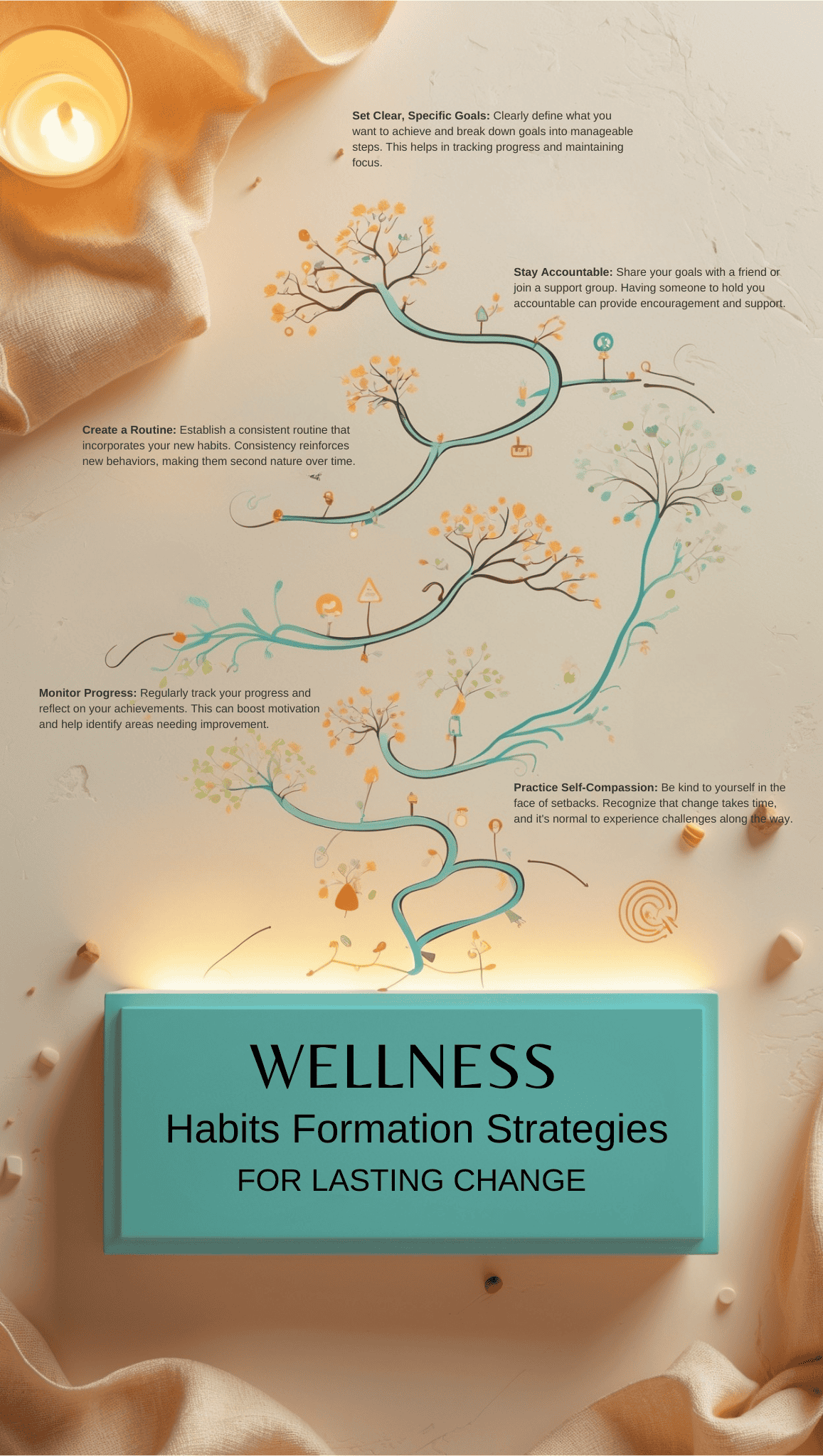
Sustainable habits create results that willpower alone never could! I’ve learned through both personal experience and behavioral science research that small, consistent actions dramatically outperform occasional heroic efforts. Understanding the mechanics of habit formation transforms wellness from an exhausting exercise in discipline to a natural flow of beneficial behaviors.
Effective habit-building works with your brain’s natural tendencies rather than fighting against them. By creating the right conditions for behavior change – including appropriate triggers, satisfying rewards, and minimal friction – you can establish wellness practices that eventually become automatic rather than requiring constant conscious effort.
Neurological Pathways of Habits
Habits create neural pathways that strengthen with repetition, eventually requiring minimal cognitive resources to maintain. Understanding this process helps design habit implementation strategies that work with rather than against brain function.
Identity-Based Habit Formation
Research suggests that habits connected to identity (“I am a person who moves daily”) establish more firmly than outcome-focused habits (“I should exercise to lose weight”). This identity alignment creates intrinsic motivation.
Environmental Design for Behavior Change
Physical environment significantly impacts habit success through visual cues, convenience factors, and friction reduction. Designing spaces that support desired behaviors dramatically increases consistency.
Steps to Create Sustainable Wellness Habits
- Start with habits so small they seem almost trivial to ensure consistent implementation
- Attach new habits to existing stable routines (habit stacking)
- Create immediate rewards for habit completion rather than focusing only on long-term benefits
- Remove friction from desired habits and add friction to habits you want to reduce
- Track consistency rather than perfection using simple visual systems
- Be patient with the habit formation process, allowing at least 66 days for automaticity
Picture This:
Imagine waking up and reaching for a glass of water that’s already on your nightstand—a habit you’ve maintained for months because you placed it there the night before as part of your bedtime routine. As you drink, you mentally review the three priorities you set last night, another habit that’s become automatic. Without thinking, you slide into your workout clothes laid out the previous evening and complete a 10-minute strength routine that began as just two push-ups months ago but has gradually expanded. You notice how these interconnected habits now flow naturally from one to the next, requiring almost no decision-making or willpower because you’ve designed your environment and routines to support these behaviors. The habit loops you’ve carefully constructed have become automatic, freeing your mental energy for the day ahead while still moving you toward your wellness goals.
15. Personalized Wellness Plan Development
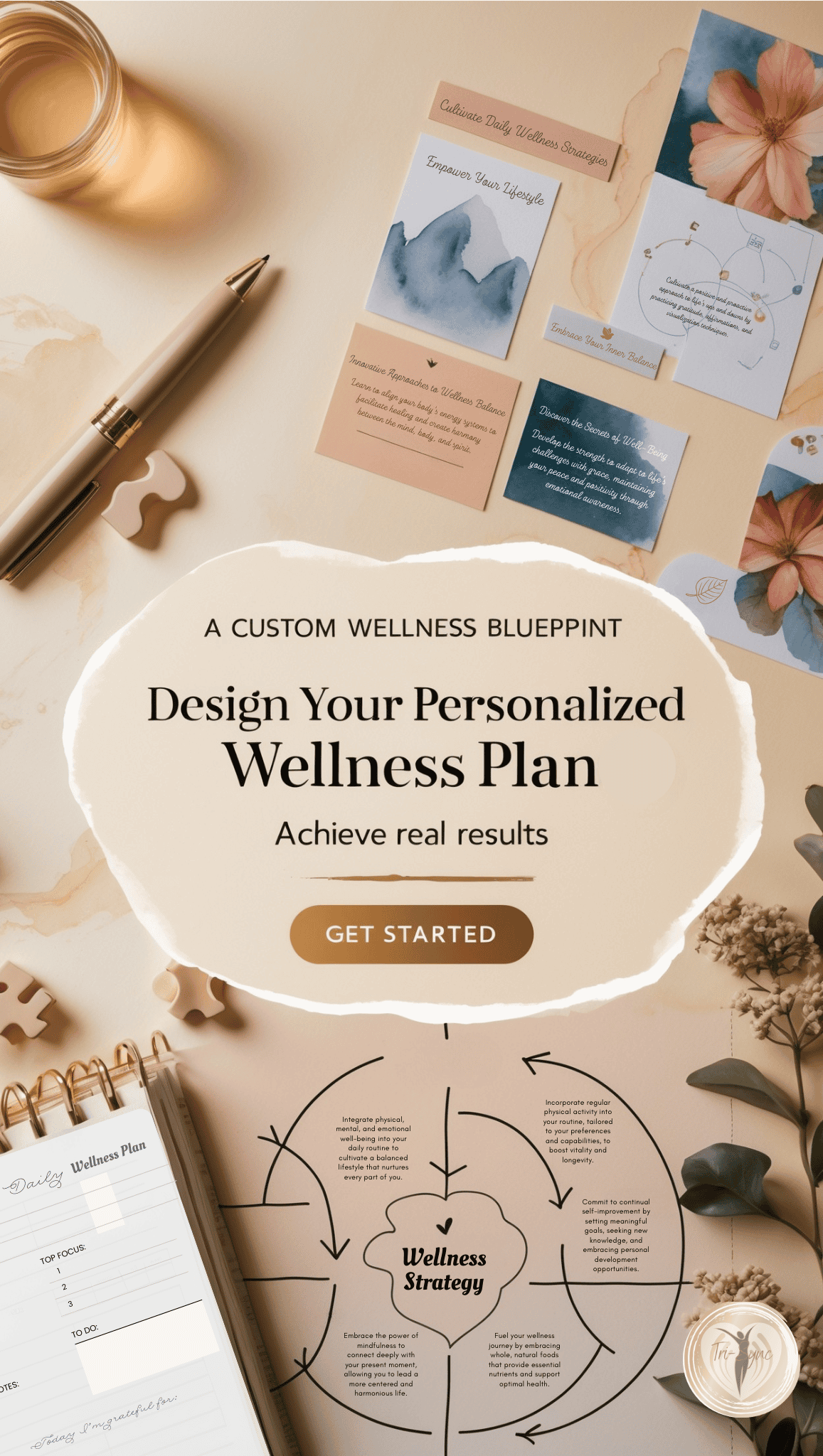
Developing a wellness plan that actually works requires moving beyond one-size-fits-all recommendations to create a truly personalized approach! I’ve learned through my own wellness journey and those of my clients that what works brilliantly for one person can be completely ineffective—or even counterproductive—for another. The true power of a personalized wellness plan comes from honest self-assessment and the willingness to experiment, observe, and adjust based on your unique body, lifestyle, preferences, and circumstances.
Too often, we try to force ourselves into wellness frameworks that don’t account for our unique situations, leading to frustration and abandonment of our goals. You deserve an approach that fits your life rather than requiring your life to fit the approach. By prioritizing practices based on your specific needs, creating realistic timelines, and building in regular evaluation periods, you’ll develop a wellness practice that evolves with you rather than becoming another abandoned project.
Steps to Create Your Personalized Wellness Plan
- Conduct a comprehensive self-assessment – Evaluate your current health status, energy levels, stress, sleep quality, and other relevant factors
- Identify your wellness values – Determine what aspects of wellness matter most to you personally
- Set specific, measurable goals – Create clear targets based on your assessment and values
- Prioritize your focus areas – Choose 1-3 aspects of wellness to address first
- Select appropriate practices – Research evidence-based approaches that align with your preferences
- Create a realistic schedule – Plan when and how you’ll implement each practice
- Build in accountability – Determine how you’ll track progress and stay motivated
- Schedule regular reviews – Set dates to assess what’s working and what needs adjustment

Want to Simplify Your Wellness Journey?
Feeling overwhelmed by all these steps? Let me help you with my Wellness Lifestyle Strong Foundation Consultation! This comprehensive audit examines your current wellness practices, identifying strengths and gaps that impact your overall well-being. During our session, I’ll guide you through a thorough assessment of your lifestyle habits, health concerns, and wellness aspirations to create a truly customized approach.
The audit includes a pre-session questionnaire to gather baseline information, a 90-minute consultation where we’ll meticulously evaluate your current wellness foundation, and personalized recommendations based on our findings. I’ll help you prioritize which practices deserve immediate attention, create realistic implementation timelines that respect your schedule, and adapt evidence-based strategies to fit your unique circumstances. You’ll leave with a clear understanding of your wellness starting point and a strategic roadmap for building a sustainable, personalized practice. Ready to establish a strong foundation for lasting wellness? Book your Wellness Lifestyle Strong Foundation Consultation today and let’s transform your approach to health and wellbeing!
Final Thoughts

Creating lasting change through effective habit formation and personalized wellness planning represents the difference between temporary improvements and true transformation in your health journey. The strategies we’ve explored—understanding habit loops, implementing micro-habits, overcoming obstacles, and tailoring approaches to your unique situation—provide a framework that works with your brain’s natural tendencies rather than against them. Remember that sustainable wellness isn’t about perfection or following someone else’s ideal regimen; it’s about discovering what genuinely works for your body, preferences, and lifestyle.
The most powerful wellness journey begins with honest self-assessment and continues with compassionate experimentation. You’ll likely discover that some widely recommended practices don’t serve you, while unexpected approaches might become cornerstone habits. This process of discovery is not just about finding what works—it’s about developing a deeper understanding of yourself and your needs.
As you implement these strategies, maintain a balance between structure and flexibility. Your wellness plan should provide enough guidance to keep you moving forward while remaining adaptable to life’s inevitable changes and challenges. Regular evaluation becomes essential—not as a way to judge your performance but as a means to refine your approach and celebrate your progress, no matter how incremental it might seem. You deserve a life that is both comforting and inspiring; the efforts we invest in ourselves cultivate the seeds of our growth.
This post may contain affiliate links. I only recommend products and services I genuinely believe in. Additionally, some images on this website may have been created with the help of AI to convey the feeling I wish to share with the reader.
Frequently Asked Questions
How long does it really take to form a new habit?
The popular 21-day timeframe is actually a myth derived from misinterpreted research. More recent studies indicate that habit formation typically takes anywhere from 18 to 254 days, with the average being around 66 days. The variability depends significantly on habit complexity, individual differences, and consistency of implementation. Rather than focusing on a specific timeframe, concentrate on creating the conditions that support habit development: clear cues, satisfying routines, and meaningful rewards.
What should I do if I keep failing to stick with my wellness habits?
Persistent difficulty maintaining habits usually indicates that your approach needs adjustment rather than reflecting personal failure. First, evaluate whether your habit is too ambitious—scaling down to a more manageable version often increases consistency. Second, examine your implementation environment for obstacles you could remove. Third, consider whether the habit truly aligns with your values and preferences; forcing yourself to adopt practices that don’t resonate with you rarely leads to lasting change.
How do I know which wellness practices to prioritize when everything seems important?
Begin by identifying your current most significant limitations—the factors most negatively impacting your quality of life or preventing other improvements. Consider both immediate impact (what would make you feel better now) and foundational importance (what creates a basis for other improvements). Sleep, stress management, and basic nutrition often provide the greatest return on investment because they influence nearly every other aspect of health.
How often should I review and adjust my personalized wellness plan?
Establish regular review intervals—typically monthly for new plans and quarterly for established ones—while remaining attentive to signals that might warrant earlier adjustment. Signs that your plan needs modification include: consistent difficulty maintaining certain practices, diminishing returns from previously effective approaches, significant life changes that affect your capacity or priorities, or new health information relevant to your situation.
About The Author
Jahlila is a Transformational Whole Self and Wellness Lifestyle Empowerment Coach, a devoted mother, passionate writer, and a fervent advocate for holistic wellness. She is the creator of The Tri-Sync Method, a comprehensive coaching program designed to help women establish a personalized wellness and self-care lifestyle for enduring total health wellness.
Her journey has transitioned from focusing solely on health and fitness to embracing a broader mission: empowering women through holistic approaches that unite body, mind, and spirit. Jahlila is dedicated to teaching, coaching, writing, and speaking about how wellness intersects with a joyful, balanced life. Her mission is to motivate women to prioritize and achieve their wellness goals, fostering a deep connection between a vibrant lifestyle and true happiness. Ready to reclaim your vitality, achieve mental clarity, and embrace your wellness journey? Explore more at The Tri-Sync Method.Com
Don’t wait another day to start living your healthiest, happiest life. Schedule a Free Discovery Consultation with Jahlila today to explore how The Tri-Sync Method can transform your life. For additional questions or personalized guidance, please visit our Contact Page.


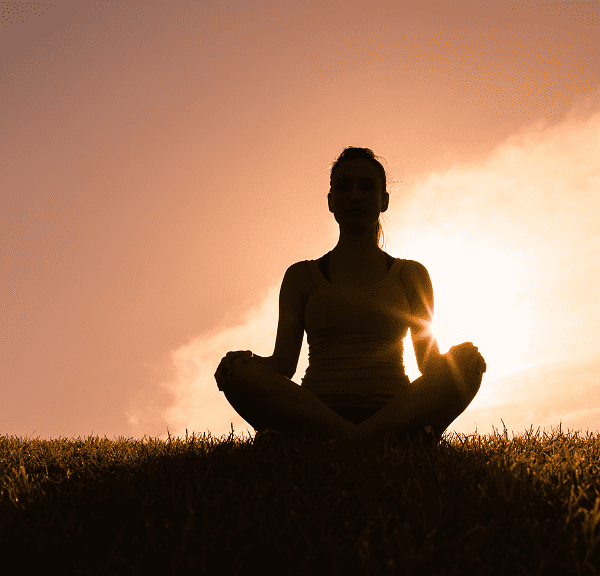

Leave a Reply